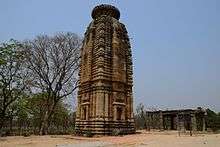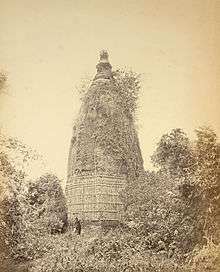Deul


.jpg)
Deul or Deoul is a local term in West India and Bengal for the tower of a Hindu temple — what would be called a shikara elsewhere in north India. In Odisha, as deula, the term can refer to temple towers, or to the whole temple. The term is also used for a style of temple architecture of Bengal, where the temple lacks the usual mandapa beside the main shrine, and the main unit consists only of the shrine and a deul above it; in other respects they are similar to the Kalinga architecture of Odisha,[1] and some smaller temples in Odisha also take this form.
The type arose between the 6th and the 10th centuries and was revived in the 16th-19th century.[2] The later representatives of this style were generally smaller and included features influenced by Islamic architecture.[2] The towers of ek-ratna temples resemble the earlier deul style, as do the central towers of pancharatna and navaratna styles.[2] The earliest temple still standing of the rekha deul pre-muslim style is Siddheshvari temple at Barakar.[3]
References
- ↑ Harle, 216
- 1 2 3 Amit Guha, Classification of Terracotta Temples, retrieved 2 February 2016
- ↑ Priyanka Mangaonkar (2012). "Temples of Bengal: Material Style and Technological Evolution" (PDF). Chitrolekha International Magazine On Art And Design. 2 (1). Archived from the original (PDF) on 27 August 2013.
- Harle, J.C., The Art and Architecture of the Indian Subcontinent, 2nd edn. 1994, Yale University Press Pelican History of Art, ISBN 0300062176
| Wikimedia Commons has media related to Deul temples. |